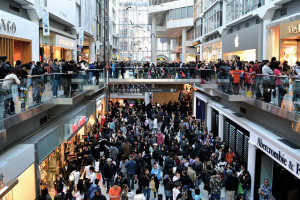This past weekend people lined up outside storefronts as well as waited patiently in online queues to score the best deals on home decor, beauty, clothing, electronics and more. Although there were still significant lines this year on Black Friday, more people opted to shop online instead of in store.
Thanksgiving/Black Friday:
According to the Star Tribune, in order to compensate for the vast amount of mobile shoppers, retailers offered the same deals online as in store, allowing the consumer to decide which route to take on Thanksgiving night and Black Friday. Consumer habits showed the majority of shoppers would first look online at specific deals, then go to the store to view in person and make their purchase. According to the National Retail Federation 34.6 million people shopped in stores on Thanksgiving but a whopping 41 million opted online. The difference was slightly smaller on Black Friday, when 74.2 million went into stores and 75.3 million shopped online.
Who excelled:
- REI: The outdoor retailer shocked the marketplace by shutting down their stores nationwide on Black Friday and paying 12,000 employees to “Opt Outside.” Media relations expert Michael Smart called the campaign “awesome” in his recent e-newsletter. Smart said the campaign brought back the true meaning of PR. Instead of buying a large ad space, telling consumers to go outside, REI gave consumers a clear action to participate. Although stores closed, the campaign was backed by more than 1 million social media users and drove site traffic up more than 10 percent.
- Minnesota State Parks: Along the same lines as REI, Minnesota state parks allowed free one-day passes to those wanting to stay away from busy shopping malls. The state parks noticed a heavy spike in admissions. Rangers at Fort Snelling State Park told Fox 9 that on a busy day they typically see 150 cars come through their gates; last Friday more than 400 cars came through.
Cyber Monday:
As the weekend concluded, analysts predicted Cyber Monday sales would hit a record $3 billion. The official tally, $3.07 billion, surpassed the predicted number. The major trend on Monday was the use of mobile users. For the first time, more shoppers used their mobile phones and tablets than their desktops, marking a turning point in consumer shopping habits.
Who excelled:
- Apple: Apple not only had great deals through their website, but other online retailers carrying Apple products were able to jump on the Apple train to make Apple products bestsellers. Apple leveraged exclusive deals with particular retailers; the iPhone 6S was $199 at Sprint and Staples offered $100 off the iPad mini/ iPad Air 2. As a result of the deals, the iPad was the best selling product on Cyber Monday.
- Amazon: The online retailer walked away with 36 percent of all online sales during Cyber Monday. Best Buy followed at a mere 5.5 percent. Amazon-exclusive devices tripled in sales.
Giving Tuesday:
Modeled after Minnesota’s Give to the Max Day, #GivingTuesday was rolled out in 2012 by Henry Timms, executive director of New York City’s 92nd Street Y community and culture center. The day was designed as a social media effort to urge holiday shoppers to give to charity after a large spending weekend.
Who excelled:
- Everyone. This year’s #GivingTuesday had 698,961 participants and donations that averaged $107.47, for a total of $116.7 million. The day brought in more than 1.3 million social media mentions and reached 917,313 users on Facebook. Although nonprofit managers say the day hasn’t moved the needle on average donations, each year #GivingTuesday grows, inspiring hope for years to come.

